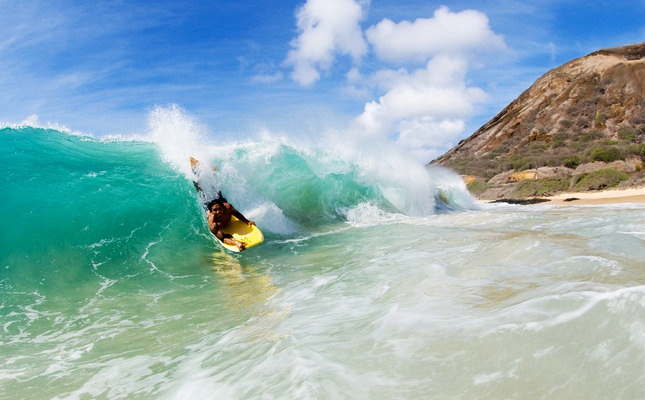[fshow photosetid=72157630771721464]
“Bet you didn’t know we have local cuisine,” asks my friend Tom, who’s graciously letting me stay in their spare apartment on my two-day layover in Hawaii, my first visit to the islands. With my half-incredulous, half-excited cry of “Really!”, he grins and flips open his computer, starting to pull up numerous web pages, undoubtedly to answer me with a resounding “yes”.
Having spent large portions of my life in South America and Asia, my taste buds have been living an exciting (and rather excited) existence. The constant exposure to countless combinations comprising varying shades of spicy, salty, sweet, sour, and bitter, has, well, made my tongue a bit of a taste snob. Having grown dependent on, and perhaps addicted to, strong gustatory stimuli, it’s not surprising to me that “western” food doesn’t really inspire the monster in my stomach to growl at the mere thought of a creamy sauce or well cooked meat and veggies.
As numerous television kitchen personalities would preach, for me it’s all about the delicate balance of subtle flavours, the key word being “delicate”. I too, enjoy a balance of flavours, but instead of a modest blend that means one part each of chilli, salt, and spices, I’d much rather keep that ratio of equals, but then kick it up a notch to, say, three parts each. My doctor doesn’t agree, but I’m not about to get into a philosophical discussion with my physician as to whether eating should be journey to seek out the secrets of a dish or a chance to let the flavours aggressively come to you. Not that there is an answer out there anyway, but if there was, I’m sure it would be a compromise along the middle path.
For as long as I can remember, my trips to the US and England were filled with amazing memories, except for one elephant-shaped void in the experience room – the cuisine. One of the few dishes I do vividly remember was buttered rice, which although ingredients are independently loved, is a strange match for me personally. Oh, and recollections of copious amounts of pepper and salt. Not that the food was terrible – it was hearty and did its job, but just wasn’t quite, well, memorable. Until that is, I went to Hawaii.
Guardians of Cuisine
“Check this out,” says Tom, interrupting me from my thoughts. He holds out a book, which I automatically reach out to take. The title reads “The New Cuisine of Hawaii – Recipes from the Twelve Celebrated Chefs of Hawaii Regional Cuisines”, under which is a close up shot of a dish presented in a tower-like verticality. That’s a feat of balance alright. “The concept was born out of a ‘grow local, buy local, and eat local’ movement,” my friend explains.
So who are the twelve apostles of the Hawaiian new cuisine? Tom rattles off a few names. I never knew him to be such a foodie, but five years is plenty of time to develop a new interest. I notice the chefs have “foreign” sounding surnames which I would later realize represent the multi-cultural aspect of modern Hawaiian cuisine – the likes of Alan Wong, Sam Choy, Roy Yamaguchi, and George Mavrothalassitis. Tom was as surprised as I was that I’d never heard of any of them, despite their local celebrity status, hosting their own cooking shows, appearing on the cover of magazines, not to mention having penned their own cookbooks as well as managing a handful of restaurants around Hawaii.
Tom was back on the phone calling up his fellow food enthusiasts. “Alan Wong’s tomorrow night then?”, he said. While I was still calculating the hours before my next flight, he added, “He cooked a luau for president Obama, you know. Plus he’s a James Beard Award winner” Alright then. Hawaiian cuisine is already starting to sound mighty enticing.
A date with taste
When we arrived at Alan Wong’s in Honolulu, one thing was certain. The lack of the view from the third floor on King Street could only mean the food would be strong enough to stand on its own. The menu wasn’t too overwhelming in terms of the number of dishes on offer, but with choices like Kona Lobster Dumplings and Macadamia and coconut-crusted lamb chops, it was hard to keep the stomach as small as the eyes. Taking the easy way out, we went for the five course menu with wine pairing, making a mental note to try one of the many Hawaiian coffees listed at the end. To this day, I still can’t pinpoint what was so “Hawaiian” about my meal, other than the fact that various culinary influences were incorporated into modern interpretations of fresh food, including a ginger-crusted snapper drizzled with Miso sesame vinaigrette, seafood lasagna, and a Kalua pig sandwich. The overall effect achieved exactly the kind of delicate flavour balance the Hawaiians would describe as “ono”. In my personal culinary thesaurus, the food was simply “yum”.
For a taste of Hawaii’s unique blend of culinary flavors, try any of the restaurants of the 12 chefs that started this movement:
- Alan Wong: Alan Wong’s Restaurant (www.alanwongs.com) in Honolulu, or The Pineapple Room (www.alanwongs.com/pineapple-room-welcome/index.html) in the Ala Moana Center, also on Oahu.
- Roy Yamaguchi: Various locations – try Roy’s Hawaii Kai (www.royshawaii.com/hawaii_kai.html) or Roy’s Waikiki (www.royshawaii.com/waikiki.html)
- George Mavrothalassitis: Chef Mavro (www.chefmavro.com) at Honolulu.
- Peter Merrimam: Merriman’s (www.merrimanshawaii.com) on Honolulu, Hula Grill Kaanapali (www.hulagrillkaanapali.com) in Maui.

